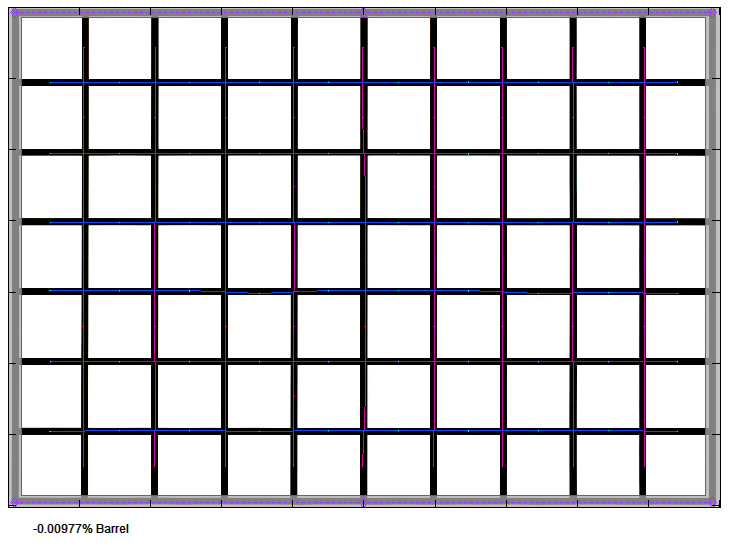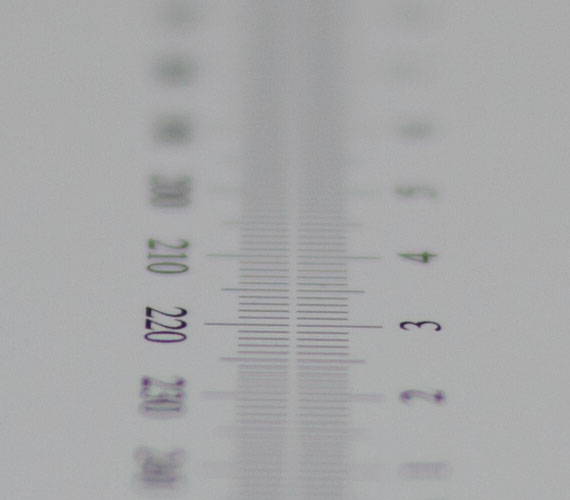|
Sigma 50mm f/1.4 DG HSM | A ("Art") - APS-C Format Review / Lens Test Report - Analysis |
|
Lens Reviews -
Canon EOS (APS-C)
|
|
Page 2 of 2

Distortion
Images taken with the Sigma lens are essentially free of distortions.

Vignetting
The Sigma lens is a full format lens and as such in enjoys a sweet spot advantage when used on APS-C DSLRs. However, there's still a moderate amount of light falloff at max. aperture (~0.7EV). In very critical scenes you may spot this but it is certainly not worrisome. The vignetting is irrelevant from f/2 onward.

MTF (resolution)
The Sigma lens certainly fulfills the high expectations in terms of resolution. The center quality is already excellent at f/1.4 and the borders and corners are already very good. More importantly and quite usual - the contrast is also very snappy for such a large aperture setting. Stopping down to f/2 doesn't change too much but there's a boost in quality at f/2.8. The peak performance is reached between f/2.8-f/8 with an excellent quality across the image frame. Diffraction has a higher impact from f/11 onward.
The centering quality of the tested sample was very good. Field curvature is not relevant.
Please note that the MTF results are not directly comparable across the different systems!
Below is a simplified summary of the formal findings. The chart shows line widths per picture height (LW/PH) which can be taken as a measure for sharpness.
If you want to know more about the MTF50 figures you may check out the corresponding Imatest Explanations

Chromatic Aberrations (CAs)
Chromatic aberrations (color shadows at harsh contrast transitions) are extremely well controlled showing readings around an average pixel width of 0.2px at the image borders.

Bokeh
One of the primary usage scenarios for a large aperture lens is to separate the main subject from the background. In such an image the quality of the bokeh (out-of-focus blur) is of major significance.
The quality of the general blur is a bit of a mixed bag. In the image foreground the bokeh is comparatively harsh with fairly distinctive contrast edges. The more critical background is, however, pretty smooth albeit not totally perfect.
 Out-of-focus highlights are very evenly rendered with no outlining effect. This is almost as good as it gets here. The more edgy aperture shape starts to show up at f/2.8.
Out-of-focus highlights are very evenly rendered with no outlining effect. This is almost as good as it gets here. The more edgy aperture shape starts to show up at f/2.8.

Bokeh Fringing
Bokeh fringing is a common issue with fast glass. As you can notice below the halos have different colors - magenta (red + blue) in front of the focus point and green beyond.
Just like most other lenses in this class, the Sigma shows some bokeh fringing at f/1.4. Stopping down reduces the issue but it's just visible at f/2.8 and gone from f/4 onward.
In addition, the series of images below also illustrate a slight focus shift when stopping down (residual spherical aberration).
|
Move the mouse cursor over the f-stop marks below to observe the respective LoCAs
|
| f/1.4 |
f/2 |
f/2.8 |
f/4 |
|

|
Sample Images
We'll provide sample image in the full format test.
VerdictOoops ... they did it again! ;-) Sigma proved once more that they are no longer a company providing budget lenses but are playing in the top league indeed. The Sigma 50mm f/1.4 DG HSM | A (Art series) is a cream-on-the-cappuccino product - at least when used on APS-C DSLRs (well, *hint* it's not bad either on full format DSLRs as well ...). In the APS-C scope it is already very sharp at f/1.4, especially in the image center. The quality is excellent across the entire image frame between f/2.8 and f/8. The lens is also comparatively punchy (high contrast) at large apertures. Lateral CA are basically absent. Same goes for image distortions. Unsurprisingly there are traces of vignetting at f/1.4 but it'll rarely be an issue in the real world. The quality of the bokeh is excellent as far as out-of-focus highlights are concerned. The generally background blur is also smooth, less so the foreground blur. The amount of bokeh fringing is typical for a lens in this class. There's a very slight focus shift when stopping down. However, the focus point mostly kept within the increasing depth-of-field except at really close focus distances.
It's no news anymore that Sigma's Art series lenses are both beautifully crafted as well as tough and it's really a joy to handle Sigma 50mm f/1.4 DG HSM | A. The AF is very fast and near silent. Don't expect speed wonders in live-view mode though.
So, in summary, "Highly Recommended", of course! Now ... that being said - is it also worth it ? Well, it is clearly better than the Canon EF 50mm f/1.2 USM L and it is also superior to the rather dated Canon EF 50mm f/1.4 USM but that's primarily at large aperture settings, less so from f/2.8 onward. However, if you invest into such a lens, you'd really like a great performance at f/1.4-f/2 and this is where the Sigma shines compared to the rest of the sanely priced competition really.
|